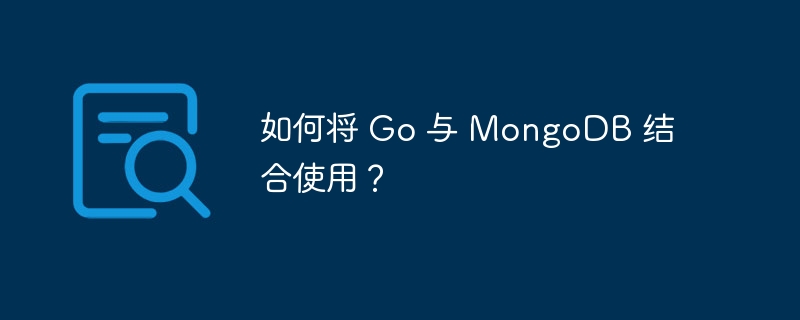How to use Go with MongoDB?

MongoDB is a popular NoSQL database that is widely used in modern web applications. Go, on the other hand, is a fast and efficient programming language that is increasingly popular for building web applications. In this article, we will discuss how to use Go with MongoDB, including how to connect to a MongoDB database and how to perform basic CRUD operations.
Install the Go version of the MongoDB driver
Before we start using Go with MongoDB, we need to install Go’s MongoDB driver. The easiest way is to use the following command -
go get go.mongodb.org/mongo-driver/mongo
This command will download and install Go's MongoDB driver, which we will use to connect to the MongoDB database.
Connect to MongoDB database
To connect to a MongoDB database using Go, we first need to create a MongoDB client object. We can do this using the following code -
clientOptions := options.Client().ApplyURI("mongodb://localhost:27017")
client, err := mongo.Connect(context.Background(), clientOptions)
if err != nil {
log.Fatal(err)
}
In this code, we create a MongoDB client object by specifying the URI of the MongoDB server. We then connect to the database using the mongo.Connect() function, passing in the context.Background() object as the first parameter.
Perform CRUD operations
After connecting to the MongoDB database using Go, we can start performing basic CRUD operations. The following code demonstrates how to insert a new document into a MongoDB collection -
collection := client.Database("mydb").Collection("users")
user := bson.M{
"name": "John",
"email": "john@example.com",
}
res, err := collection.InsertOne(context.Background(), user)
if err != nil {
log.Fatal(err)
}
id := res.InsertedID
fmt.Println("Inserted document with ID:", id)
In this code, we create a new document object using the bson.M type, which is used to represent MongoDB documents in Go. We then insert the document into the MongoDB collection using the collection.InsertOne() function, which returns a result object containing the ID of the newly inserted document.
in conclusion
In summary, using Go with MongoDB is a simple process and can be accomplished using Go’s official MongoDB driver. Following the steps outlined in this article, you can use Go to connect to a MongoDB database and perform basic CRUD operations, such as inserting documents into a collection. As you become more familiar with Go and MongoDB, you can use these tools to build complex web applications that can scale to meet the needs of your users.
The above is the detailed content of How to use Go with MongoDB?. For more information, please follow other related articles on the PHP Chinese website!

Hot AI Tools

Undresser.AI Undress
AI-powered app for creating realistic nude photos

AI Clothes Remover
Online AI tool for removing clothes from photos.

Undress AI Tool
Undress images for free

Clothoff.io
AI clothes remover

AI Hentai Generator
Generate AI Hentai for free.

Hot Article

Hot Tools

Notepad++7.3.1
Easy-to-use and free code editor

SublimeText3 Chinese version
Chinese version, very easy to use

Zend Studio 13.0.1
Powerful PHP integrated development environment

Dreamweaver CS6
Visual web development tools

SublimeText3 Mac version
God-level code editing software (SublimeText3)

Hot Topics
 How do you alter a table in MySQL using the ALTER TABLE statement?
Mar 19, 2025 pm 03:51 PM
How do you alter a table in MySQL using the ALTER TABLE statement?
Mar 19, 2025 pm 03:51 PM
The article discusses using MySQL's ALTER TABLE statement to modify tables, including adding/dropping columns, renaming tables/columns, and changing column data types.
 How do I configure SSL/TLS encryption for MySQL connections?
Mar 18, 2025 pm 12:01 PM
How do I configure SSL/TLS encryption for MySQL connections?
Mar 18, 2025 pm 12:01 PM
Article discusses configuring SSL/TLS encryption for MySQL, including certificate generation and verification. Main issue is using self-signed certificates' security implications.[Character count: 159]
 How do you handle large datasets in MySQL?
Mar 21, 2025 pm 12:15 PM
How do you handle large datasets in MySQL?
Mar 21, 2025 pm 12:15 PM
Article discusses strategies for handling large datasets in MySQL, including partitioning, sharding, indexing, and query optimization.
 What are some popular MySQL GUI tools (e.g., MySQL Workbench, phpMyAdmin)?
Mar 21, 2025 pm 06:28 PM
What are some popular MySQL GUI tools (e.g., MySQL Workbench, phpMyAdmin)?
Mar 21, 2025 pm 06:28 PM
Article discusses popular MySQL GUI tools like MySQL Workbench and phpMyAdmin, comparing their features and suitability for beginners and advanced users.[159 characters]
 How do you drop a table in MySQL using the DROP TABLE statement?
Mar 19, 2025 pm 03:52 PM
How do you drop a table in MySQL using the DROP TABLE statement?
Mar 19, 2025 pm 03:52 PM
The article discusses dropping tables in MySQL using the DROP TABLE statement, emphasizing precautions and risks. It highlights that the action is irreversible without backups, detailing recovery methods and potential production environment hazards.
 How do you represent relationships using foreign keys?
Mar 19, 2025 pm 03:48 PM
How do you represent relationships using foreign keys?
Mar 19, 2025 pm 03:48 PM
Article discusses using foreign keys to represent relationships in databases, focusing on best practices, data integrity, and common pitfalls to avoid.
 How do you create indexes on JSON columns?
Mar 21, 2025 pm 12:13 PM
How do you create indexes on JSON columns?
Mar 21, 2025 pm 12:13 PM
The article discusses creating indexes on JSON columns in various databases like PostgreSQL, MySQL, and MongoDB to enhance query performance. It explains the syntax and benefits of indexing specific JSON paths, and lists supported database systems.
 How do I secure MySQL against common vulnerabilities (SQL injection, brute-force attacks)?
Mar 18, 2025 pm 12:00 PM
How do I secure MySQL against common vulnerabilities (SQL injection, brute-force attacks)?
Mar 18, 2025 pm 12:00 PM
Article discusses securing MySQL against SQL injection and brute-force attacks using prepared statements, input validation, and strong password policies.(159 characters)






